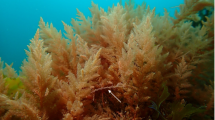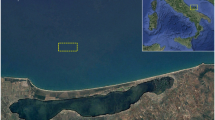Abstract
Large-scale losses of spat are commonplace during the early stages of mussel aquaculture costing the industry millions in lost production. The dominant cause of this poor spat retention is thought to be secondary settlement behavior, whereby spat detach from farming substrata in an effort to relocate to another site. One approach that could be used to reduce these spat losses is to use natural substrates, such as macroalgae, to which wild mussel spat commonly attach. These natural substrates are often associated with chemical and morphological settlement cues. In New Zealand, the majority of mussel spat used by the aquaculture industry are harvested from the wild while attached to a range of species of macroalgae and other general debris (referred to as Kaitaia spat material). The filamentous morphology and chemicals released by some of these macroalgal species, including the rhodophyte Pterocladia lucida, have been shown to improve mussel settlement. Therefore, in this study, the spat of the green-lipped mussel, Perna canaliculus, were seeded onto aquaculture grow ropes with and without P. lucida to determine whether the presence of the macroalgae would improve the retention of the mussel spat. The presence of P. lucida increased spat retention by 33% relative to a control over 12 weeks and also increased the proportion of spat (by 16%) that successfully migrated away from biodegradable seeding substrata onto the permanent structure of the grow rope. The timing of spat losses relative to the breakdown of seeding substrata is consistent with the macroalga producing chemical cues that encourage spat settlement. In contrast, no spat attached directly to the P. lucida suggesting morphology of the macroalga was not playing a role in the observed increase in spat retention. These results suggest that there may be chemical cues present in P. lucida that may have the potential to be used to help resolve the problem of poor spat retention in green-lipped mussel aquaculture.






Similar content being viewed by others
Data availability
Data will be made available from the corresponding author upon reasonable request.
References
Alfaro AC, Jeffs AG (2002) Small-scale mussel settlement patterns within morphologically distinct substrata at Ninety Mile Beach, northern New Zealand. Malacologia 44(15):1–5
Alfaro AC, Jeffs AG, Creese RG (2004) Bottom-drifting algal/mussel spat associations along a sandy coastal region in northern New Zealand. Aquaculture 241(1):269–290
Alfaro AC, Copp BR, Appleton DR, Kelly S, Jeffs AG (2006) Chemical cues promote settlement in larvae of the green-lipped mussel, Perna canaliculus. Aquac Int 14:405–412
Ank G, Porto TF, Pereira RC, da Gama BAP (2009) Effects of different biotic substrata on mussel attachment. Biofouling 25(2):173–180
Aquaculture New Zealand. (2019). Overview of New Zealand aquaculture., www.aquaculture.org.nz/industry/overview/(accessed on 8 Jan 2020).
Bao W, Satuito C, Yang J, Kitamura H (2007) Larval settlement and metamorphosis of the mussel Mytilus galloprovincialis in response to biofilms. Mar Biol 150(4):565–574
Bayne BL (1964) Primary and secondary settlement in Mytilus edulis L. (Mollusca). J Anim Ecol 33(3):513
Board P (1983) The settlement of post larval Mytilus edulis (settlement of post larval mussels). J Molluscan Stud 49(1):53–60
Bonar DB, Coon SL, Walch M, Weiner RM, Fitt W (1990) Control of oyster settlement and metamorphosis by endogenous and exogenous chemical cues. Bull Mar Sci 46(2):484–498
Brenner M, Buck BH (2010) Attachment properties of blue mussel (Mytilus edulis L.) byssus threads on culture-based artificial collector substrates. Aquac Eng 42(3):128–139
Bryan PJ, Kreider JL, Qian P (1998) Settlement of the serpulid polychaete Hydroides elegans (Haswell) on the arborescent bryozoan Bugula neritina (L.): evidence of a chemically mediated relationship. J Exp Mar Biol Ecol 220:171–190
Buchanan S, Babcock R (1997) Primary and secondary settlement by the greenshell mussel Perna canaliculus. Oceanogr Lit Rev 12(44):1500
Bulleri F, Airoldi L, Branca GM, Abbiati M (2006) Positive effects of the introduced green alga, Codium fragile ssp. tomentosoides, on recruitment and survival of mussels. Mar Biol 148(6):1213–1220
Carl C, Poole AJ, Williams MR, de Nys R (2012a) Where to settle—settlement preferences of Mytilus galloprovincialis and choice of habitat at a micro spatial scale. PLoS One 7(12):e52358
Carl C, Poole AJ, Sexton BA, Glenn FL, Vucko MJ, Williams MR, Whalan S, de Nys R (2012b) Enhancing the settlement and attachment strength of pediveligers of Mytilus galloprovincialis bychanging surface wettability and microtopography. Biofouling 28(2):175–186
Christensen HT, Dolmer P, Hansen BW, Holmer M, Kristensen LD, Poulsen LK, Stenberg C, Albertsen CM, Støttrup JG (2015) Aggregation and attachment responses of blue mussels, Mytilus edulis—impact of substrate composition, time scale and source of mussel seed. Aquaculture 435:245–251
Davis AR, Moreno CA (1995) Selection of substrata by juvenile Choromytilus chorus (Mytilidae): are chemical cues important? J Exp Mar Biol Ecol 191(2):167–180
Dobretsov SV (1999) Effects of macroalgae and biofilm on settlement of blue mussel (Mytilus edulis l.) larvae. Biofouling 14(2):153–165
Dobretsov SV, Qian P (2003) Pharmacological induction of larval settlement and metamorphosis in the blue mussel Mytilus edulis L. Biofouling 19(1):57–63
Eyster LS, Pechenik JA (1988) Attachment of Mytilus edulis L. larvae on algal and byssal filaments is enhanced by water agitation. J Exp Mar Biol Ecol 114(2):99–110
Filgueira R, Peteiro LG, Labarta U, Fernández-Reiriz MJ (2007) Assessment of spat collector ropes in Galician mussel farming. Aquac Eng 37(3):195–201
Frandsen RP, Dolmer P (2002) Effects of substrate type on growth and mortality of blue mussels (Mytilus edulis) exposed to the predator Carcinus maenas. Mar Biol 141(2):253–262
Ganesan AM, Alfaro AC, Higgins CM, Duxbury M, Brooks JD (2012) Characterization of biofilm exudates and their effects on settlement of mussel (Perna canaliculus) larvae. J Exp Mar Biol Ecol 434-435:34–46
García-Lavandeira M, Silva A, Abad M, Pazos AJ, Sánchez JL, Luz Pérez-Parallé M (2005) Effects of GABA and epinephrine on the settlement and metamorphosis of the larvae of four species of bivalve molluscs. J Exp Mar Biol Ecol 316(2):149–156
Gribben PE, Jeffs AG, de Nys R, Steinberg PD (2011) Relative importance of natural cues and substrate morphology for settlement of the New Zealand GreenshellTM mussel, Perna canaliculus. Aquaculture 319(1-2):240–246
Hickman RW (1976) Potential for the use of stranded seed mussels in mussel farming. Aquaculture 9:287–293
Huggett M, de Nys R, Williamson J, Heasman M, Steinberg P (2005) Settlement of larval blacklip abalone, Haliotis rubra, in response to green and red macroalgae. Mar Biol 147(5):1155–1163
Jeffs AG, Delorme NJ, Stanley J, Zamora LN, Sim-Smith C (2018) Composition of beachcast material containing green-lipped mussel (Perna canaliculus) seed harvested for aquaculture in New Zealand. Aquaculture 488:30–38
Jensen RA, Morse DE (1990) Chemically induced metamorphosis of polychaete larvae in both the laboratory and ocean environment. J Chem Ecol 16(3):911–930
Kamermans P, Capelle J (2019). Provisioning of mussel seed and its efficient use in culture. Goods and services of marine bivalves (pp. 27-49) Springer.
Lane DJW, Beaumont AR, Hunter JR (1985) Byssus drifting and the drifting threads of the young post-larval mussel Mytilus edulis. Mar Biol 84(3):301–308
Le Corre N, Martel AL, Guichard F, Johnson LE (2013) Variation in recruitment: differentiating the roles of primary and secondary settlement of blue mussels Mytilus spp. Marine Ecology. Progress Series 481:133–146
Mercier A, Battaglene SC, Hamel J (2000) Settlement preferences and early migration of the tropical sea cucumber Holothuria scaba. J Exp Mar Biol Ecol 249:89–110
Morse ANC, Morse DE (1984) Recruitment and metamorphosis of Haliotis larvae induced by molecules uniquely available at the surfaces of crustose red algae. J Exp Mar Biol Ecol 75(3):191–215
Schiel DR, Nelson WA (1990) The harvesting of macroalgae in New Zealand. Hydrobiologia 204-205(1):25–33
Skelton BM, Jeffs AG (2020) The importance of physical characteristics of settlement substrate to the retention and fine-scale movements of Perna canaliculus spat in suspended longline aquaculture. Aquaculture 521:735054
Skelton BM, McKay WJ, Jeffs AG (2021) Evaluation of a floating upwelling system for nursery culture of the Greenshell™ mussel (Perna canaliculus). Aquac Res. https://doi.org/10.1111/are.15210
Soares AR, de Gama BAP, da Cunha AP, Teixeira VL, Pereira RC (2008) Induction of attachment of the mussel Perna perna by natural products from the brown seaweed Stypopodium zonale. Mar Biotechnol 10(2):158–165
South PM, Floerl O, Jeffs AG (2017) Differential effects of adult mussels on the retention and fine-scale distribution of juvenile seed mussels and biofouling organisms in long-line aquaculture. Aquaculture Environment Interactions 9:239–256
South PM, Floerl O, Jeffs AG (2020) Magnitude and timing of seed losses in mussel (Perna canaliculus) aquaculture. Aquaculture 515:734528
Supono S, Dunphy B, Jeffs A (2020) Retention of green-lipped mussel spat: the roles of body size and nutritional condition. Aquaculture 520:735017
Swanson RL, de Nys R, Huggett MJ, Green JK, Steinberg PD (2006) In situ quantification of a natural settlement cue and recruitment of the Australian sea urchin Holopneustes purpurascens. Mar Ecol Prog Ser 314:1–14
Walters LJ, Hadfield MG, Smith CM (1996) Waterborne chemical compounds in tropical macroalgae: positive and negative cues for larval settlement. Mar Biol 126(3):383–393
Yang J, Satuito C, Bao W, Kitamura H (2007) Larval settlement and metamorphosis of the mussel Mytilus galloprovincialis on different macroalgae. Mar Biol 152(5):1121–1132
Zazzaro D, Ruggiero K, Jeffs A (2018) Use of extract from adults of the triangle barnacle, Balanus trigonus, for reducing fouling in mussel farms. Aquaculture 483:223–229
Zhao B, Zhang S, Qian P (2003) Larval settlement of the silver- or goldlip pearl oyster Pinctada maxima (Jameson) in response to natural biofilms and chemical cues. Aquaculture 220(1):883–901
Acknowledgements
We thank Gold Ridge Marine Farms Ltd. for providing Kaitaia spat, access to the mussel farm site, and for logistic support.
Code availability
Code will be made available from the corresponding author upon reasonable request.
Funding
This research was funded by the Ministry for Primary Industries.
Author information
Authors and Affiliations
Corresponding author
Ethics declarations
Ethics statement
Ethics approval was not required.
Competing interests
The authors declare no competing interests.
Additional information
Publisher’s note
Springer Nature remains neutral with regard to jurisdictional claims in published maps and institutional affiliations.
Handling Editor: Gavin Burnell
Rights and permissions
About this article
Cite this article
Skelton, B.M., Jeffs, A.G. An assessment of the use of macroalgae to improve the retention of Greenshell™ mussel (Perna canaliculus) spat in longline culture. Aquacult Int 29, 1683–1695 (2021). https://doi.org/10.1007/s10499-021-00710-9
Received:
Accepted:
Published:
Issue Date:
DOI: https://doi.org/10.1007/s10499-021-00710-9




